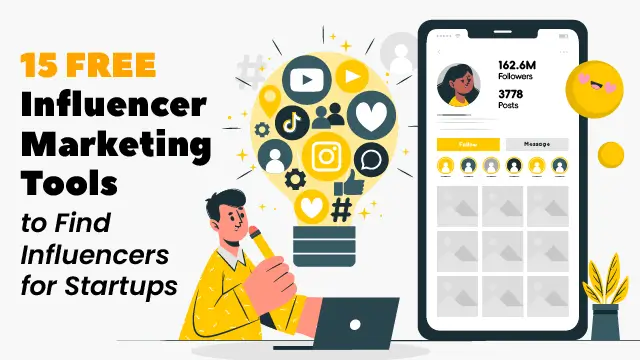15 FREE Influencer Marketing Tools to Find Influencers for Startups
Are you struggling to find the right influencers for your startup to boost growth? For startups, influencer marketing is often the quickest route to growth—but without the right tools, it can become a major time drain. What’s more, according to a report by Brandwatch, 63% of marketers say measuring ROI is their biggest influencer marketing challenge. The good news: free tools can help bridge these gaps, enabling startups to identify influencers, engage audiences, and track results without any cost. Let’s explore some powerful tools that can simplify and supercharge your influencer marketing journey.

Before diving into tools, let’s go through the steps about influencer marketing to get a better understand of what tools fit you best.
Step 1: How to Define Your Ideal Influencer Persona
Before diving into tools, it’s essential to identify the type of influencer who aligns with your brand values.
For instance:
- Target Audience: Consider what demographic your brand serves and what type of influencer speaks to them
- Niche: Whether your startup is in tech, fitness, fashion, or food, the influencer’s niche matters. Aim for influencers who align with your brand’s message.
- Engagement Metrics: Look beyond follower count to engagement rates and quality of interactions, which often reveal how trusted and influential they are within their audience.
Step 2: Types of Influencers to Consider: Nano, Micro, Macro, and Mega
Different influencers serve different purposes, especially depending on the campaign scope and your budget:
- Nano-Influencers (1K-10K followers): Great for hyper-local or niche campaigns where budget is limited. Pros: Genuine, Dedicated followers. Cons: Lack experience
- Micro-Influencers (10K-100K followers): Ideal for a balance of reach and engagement, micro-influencers can drive brand trust and are usually more affordable.
- Macro & Mega Influencers (100K+ followers): Typically for startups with larger budgets looking to boost brand awareness quickly.
Step 3: Using the Right Tool to Find Influencers
After researching Influencers, it’s time to Reach out to Influencers, then Negotiate terms with them. The whole procedure would be few rounds, you’ll need to list your purpose and the link or name you want the influencer to include in their content. It’s usually nice to give them freedom about your product and provide some link you need. Remember to set UTM source code or code with influencers name to measure ROI.
The 15 Free Influencer Marketing Tools to Accelerate Your Startup’s Growth
1. Modash
- Featured Function: Advanced influencer discovery and audience analysis.
- Social Media Platform Compatibility: Instagram, TikTok, YouTube.
- Search and Filter Capabilities: Filter by audience size, interests, and location.
- Data: Over 100 million influencers, engagement rates, and audience demographics.
- Limitations With Free Version: Limited influencer searches per month.
- Pros and Cons: Comprehensive audience analytics but lacks CRM features.
2. Kitly Business
- Featured Function: Campaign management and automated outreach.
- Social Media Platform Compatibility: Instagram and TikTok
- Search and Filter Capabilities: Automated searches by brand goals.
- Data: Tracks content engagement and influencer collaboration details.
- Limitations With Free Version: Limited integrations and automations.
- Pros and Cons: Great for outreach automation, but lacks integration with non-social channels.
3. HypeAuditor
- Featured Function: Audience authenticity analysis and engagement metrics.
- Social Media Platform Compatibility: Instagram, YouTube, and TikTok.
- Search and Filter Capabilities: Filters influencers based on audience quality and niche.
- Data: Tracks audience demographics, fake followers, and engagement authenticity.
- Limitations With Free Version: Limited access to in-depth metrics.
- Pros and Cons: Best for authenticity checks but has restrictions on advanced reports.
4. Shopify Collabs (Formerly Dovetale)
- Featured Function: eCommerce influencer partnerships and affiliate management.
- Social Media Platform Compatibility: Instagram, TikTok, and more.
- Search and Filter Capabilities: Search by product niche and follower count.
- Data: Sales conversions, affiliate tracking, and commission insights.
- Limitations With Free Version: Limited access to affiliate features.
- Pros and Cons: Excellent eCommerce integration but less comprehensive for non-commerce brands.
5. Storyclash
- Featured Function: Content analysis and influencer insights.
- Social Media Platform Compatibility: Instagram and YouTube.
- Search and Filter Capabilities: Discover trending topics and viral influencers.
- Data: Real-time tracking of trending content and influencer reach.
- Limitations With Free Version: Limited access to real-time reports.
- Pros and Cons: Great for real-time insights, but lacks CRM functions.
6. Bazaarvoice (Formerly Affable.ai)
- Featured Function: Influencer discovery and ROI tracking.
- Social Media Platform Compatibility: Instagram, Facebook, and TikTok.
- Search and Filter Capabilities: Search by industry-specific niches and audience type.
- Data: Engagement rates, reach, and campaign ROI metrics.
- Limitations With Free Version: Limited to a few campaign reports.
- Pros and Cons: Ideal for ROI tracking but not as feature-rich in outreach.
7. Influence.co
- Featured Function: Influencer community and campaign collaborations.
- Social Media Platform Compatibility: Instagram, YouTube, and more.
- Search and Filter Capabilities: Discover influencers by niches and campaigns.
- Data: Engagement statistics, influencer portfolios, and campaign analytics.
- Limitations With Free Version: Fewer customization options.
- Pros and Cons: Excellent for finding influencers, but limited advanced features.
8. Discover.ly
- Featured Function: Influencer network discovery and connection insights.
- Social Media Platform Compatibility: LinkedIn and Facebook.
- Search and Filter Capabilities: Discover connections through your existing network.
- Data: Influencer connections and shared networks.
- Limitations With Free Version: Basic social insights only.
- Pros and Cons: Great for expanding your network, but limited analytics.
- Featured Function: Top blogs and influencers in your niche.
9. Alltop
- Featured Function: Top blogs and influencers in your niche.
- Social Media Platform Compatibility: Blogs and media sites.
- Search and Filter Capabilities: Discover top bloggers in multiple industries.
- Data: Top content categories and trending blogs.
- Limitations With Free Version: Limited filtering by industry.
- Pros and Cons: Great for blog discovery but lacks real-time updates.
10. Podbay.fm
- Featured Function: Discover top podcast influencers in various niches.
- Social Media Platform Compatibility: Podcasts and audio channels.
- Search and Filter Capabilities: Search by podcast rankings and niche.
- Data: Top charts, podcast stats, and trending shows.
- Limitations With Free Version: Limited to podcast search.
- Pros and Cons: Excellent for podcasts, but limited beyond audio.
11. Crowdfire
- Featured Function: Content curation and influencer engagement.
- Social Media Platform Compatibility: Instagram, Twitter, Facebook, and LinkedIn.
- Search and Filter Capabilities: Search by interests, hashtags, and topics.
- Data: Content performance metrics and engagement rates.
- Limitations With Free Version: Limited to a few accounts.
- Pros and Cons: Great for content management but limited influencer discovery tools.
12. Hunter.io
- Featured Function: Email lookup and influencer outreach.
- Social Media Platform Compatibility: Email and social links.
- Search and Filter Capabilities: Search for professional email addresses.
- Data: Email validation and deliverability stats.
- Limitations With Free Version: Limited email lookups per month.
- Pros and Cons: Excellent for outreach but not a full CRM solution.
13. Brandwatch
- Featured Function: Influencer insights and sentiment analysis.
- Social Media Platform Compatibility: Twitter, Instagram, YouTube, and more.
- Search and Filter Capabilities: Monitor influencers by sentiment and engagement.
- Data: Real-time sentiment, brand mentions, and influencer insights.
- Limitations With Free Version: Limited real-time updates.
- Pros and Cons: Strong on analytics but lacks outreach features.
- Featured Function: Competitor analysis and influencer tracking.
- Social Media Platform Compatibility: Blogs, websites, and social media.
- Search and Filter Capabilities: Search influencers by keyword and industry
- Data: Traffic stats, backlink data, and competitor insights.
- Limitations With Free Version: Limited advanced data.
- Pros and Cons: Great for keyword-based influencer discovery, but limited social insights.
15. Sequioa One
- Featured Function: Compeltely Free All-in-one analytics and influencer marketing platform.
- Social Media Platform Compatibility: Instagram, TikTok, YouTube, and Android Apps on Google Play.
- Search and Filter Capabilities: Advanced app performance insights and influencer trends.
- Data: App ranking stats, influencer impact metrics, and growth insights.
- Limitations With Free Version: Limited integrations with external tools.
- Pros and Cons: Powerful for app-focused brands that are Android Users Oriented, less powerful for IOS Users in regard to app- built brands. Great tool for finding right influencers, limited access to campagin management for now.
Step 4: Key Metrics to Look for When Choosing Influencers
When evaluating influencers, these metrics can help you find those with true reach:
- Engagement Rate: High engagement (likes, comments, shares) indicates an active audience. Go to each influencer's profile from sequone, for example, Mr. Beast's profile. you can get a clear view of their impact by checking their influencer score and other detailed engagement rates.
- Audience Demographics: Ensure the influencer’s audience matches your target customer profile.
- Content Quality & Consistency: Look for influencers who post quality content regularly; this shows professionalism and can improve campaign impact.
How to Use Free Tools Effectively on a Startup Budget
Here’s a strategy I recommend: leverage multiple tools to cover different needs. For example, use Social Blade for growth trends, HypeAuditor for engagement rates, and BuzzSumo to find trending content in your industry. By combining the unique features of each tool, you’ll get a comprehensive view of potential influencers and only pay if you need additional premium features.
Best Practices for Reaching Out to Influencers
Approaching influencers can be tricky for startups, so here are a few tried-and-true tips:
1. Personalized Outreach: Show genuine interest in their content and explain why you think there’s synergy between their profile and your brand.
2. Value Proposition: Offer value—like potential exposure, mutual giveaways, or creative collaboration ideas—that benefits both you and the influencer.
3. Build Long-Term Relationships: Instead of one-off promotions, consider establishing longer partnerships, as these yield more authentic brand advocacy.
Tracking and Measuring Influencer Campaign Success
Using free tools doesn’t mean you can’t measure success. Many of the tools listed provide basic campaign analytics.
Here’s how to track key metrics:
Engagement & Reach: Platforms like Instagram and TikTok provide reach and impression data directly. Sequoia One offers completely free data for influencers across Youtube/Instgram/TikTok. Use these numbers to gauge how well the influencer's audience is responding.
Referral Links & Discount Codes: Set up specific links or promo codes to track conversions, providing a direct measure of your campaign’s impact.
Conversions: If your goal is to drive sales, use tools like Google Analytics to track referral traffic from influencer campaigns.
Maximize Your Reach with the Right Influencer Marketing Strategy
Influencer marketing is an evolving field, but the right tools and a strategic approach can give startups a big edge. Use these free tools to grow your brand's reach and visibility without sacrificing your budget. Building strong influencer partnerships takes time and effort, but the results are well worth it.
FAQ for Influencer Marketing
What Are Influencer Marketing Tools?
Influencer marketing tools are designed to simplify influencer discovery, relationship management, and campaign tracking. Key features include:
- Influencer Discovery and Search Filters: Modash stands out for its advanced filtering.
- Campaign Management and Outreach: Kitly Business excels in this area.
- Audience Authenticity Checks: Sequioa One is ideal for identifying genuine audiences.
- Tracking and Reporting: Brandwatch’s comprehensive analytics are top-notch.
- App Integration for eCommerce: Shopify Collabs offers seamless eCommerce integration.
Top Industries Benefiting the Most from Influencer Marketing
1. Fashion and Beauty: Visual content reigns supreme here, with influencers showcasing makeup tutorials, styling tips, and product recommendations.
2. Health and Fitness: From workout routines to wellness advice, fitness influencers engage audiences seeking a healthier lifestyle.
3. Tech and Mobile Apps: Tech influencers build brand credibility by reviewing gadgets, apps, and new innovations.
4. Travel and Hospitality: Collaborations with travel influencers allow brands to showcase experiences and unique destinations.
Why Influencer Marketing Tools Matter for Startups?
The right tools can streamline discovery and management, slashing research time in half. They offer data-driven insights to maximize returns and track performance effectively. Without them, startups risk inefficiencies, missed opportunities, and wasted budgets.
Conclusion
From Modash to Sequioa One, each of these 15 tools brings something unique to the table. Whether you’re looking to find the perfect influencers, streamline outreach, or measure ROI, there’s a free tool to get you started without overspending. So, dive in, explore, and take your startup’s influencer marketing game to the next level!
Ready to take the plunge? Explore these tools and see which ones fit your startup’s needs. Your App growth and the right influencer could be just a click away!
Try those follwoing free tools to boost your business!


I like to talk about influencers across TikTok/YouTube/Instgram share intersting topics to light up your day. My focus is on simplifying influencer marketing and providing strategies that help brands of all sizes reach and engage their ideal audience effectively.
 More Popular Reports
More Popular Reports
-
 Roth IRA Beginner Guide 2025: How I Turned $100 a Month Into Tax-Free FreedomRoth IRA beginner guide Roth IRA contribution limits 2025 Roth IRA vs 401(k) how to start investing at 20
Roth IRA Beginner Guide 2025: How I Turned $100 a Month Into Tax-Free FreedomRoth IRA beginner guide Roth IRA contribution limits 2025 Roth IRA vs 401(k) how to start investing at 20 -
 Inflation & You: A Practical Guide to Protecting Your Purchasing PowerInflation Purchasing Power Investment Strategy High-Yield Savings TIPS Debt Management
Inflation & You: A Practical Guide to Protecting Your Purchasing PowerInflation Purchasing Power Investment Strategy High-Yield Savings TIPS Debt Management

 Share
Share
